Page 153 of 417
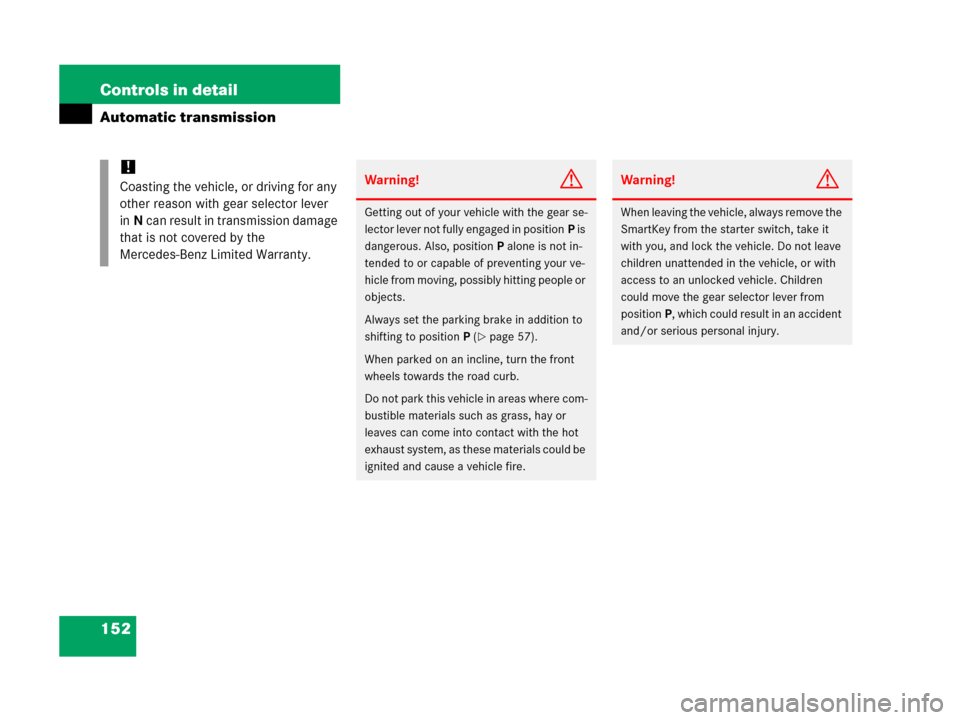
152 Controls in detail
Automatic transmission
!
Coasting the vehicle, or driving for any
other reason with gear selector lever
inN can result in transmission damage
that is not covered by the
Mercedes-Benz Limited Warranty.Warning!G
Getting out of your vehicle with the gear se-
lector lever not fully engaged in positionP is
dangerous. Also, positionP alone is not in-
tended to or capable of preventing your ve-
hicle from moving, possibly hitting people or
objects.
Always set the parking brake in addition to
shifting to positionP (
�page 57).
When parked on an incline, turn the front
wheels towards the road curb.
Do not park this vehicle in areas where com-
bustible materials such as grass, hay or
leaves can come into contact with the hot
exhaust system, as these materials could be
ignited and cause a vehicle fire.
Warning!G
When leaving the vehicle, always remove the
SmartKey from the starter switch, take it
with you, and lock the vehicle. Do not leave
children unattended in the vehicle, or with
access to an unlocked vehicle. Children
could move the gear selector lever from
positionP, which could result in an accident
and/or serious personal injury.
Page 154 of 417

153 Controls in detail
Automatic transmission
Driving tips
Accelerator position
Your driving style influences the
transmission’s shifting behavior:
Less throttle Earlier upshifting
More throttle Later upshifting
Kickdown
Use kickdown when you want maximum
acceleration.
�Press the accelerator past the point of
resistance.
The transmission shifts into a lower
gear.
�Ease on the accelerator when you have
reached the desired speed.
The transmission shifts up again.Stopping
When you stop briefly, e.g. at traffic lights:
�Leave the transmission in gear.
�Hold the vehicle with the brake.
When you stop longer with the engine
idling and/or on a hill:
�Set the parking brake.
�Move the gear selector lever to
positionP.Maneuvering
When you maneuver in tight areas,
e.g. when pulling into a parking space:
�Control the vehicle speed by gradually
releasing the brakes.
�Accelerate gently.
�Never abruptly step on the accelerator.
Working on the vehicle
Warning!G
When working on the vehicle, set the
parking brake and move gear selector lever
to positionP. Otherwise the vehicle could
roll away.
Page 155 of 417
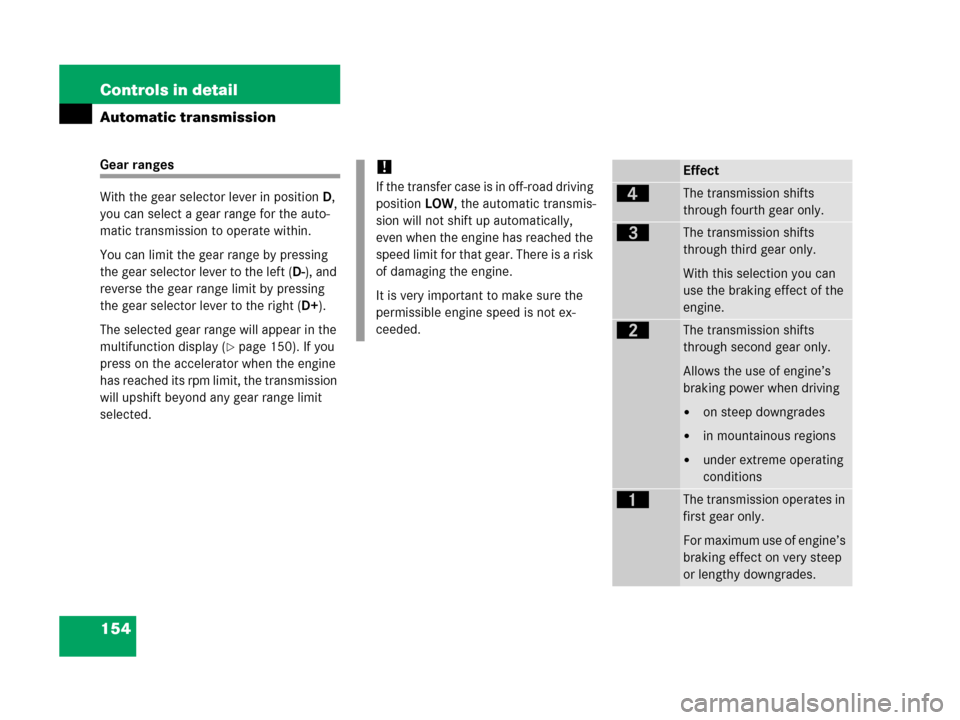
154 Controls in detail
Automatic transmission
Gear ranges
With the gear selector lever in positionD,
you can select a gear range for the auto-
matic transmission to operate within.
You can limit the gear range by pressing
the gear selector lever to the left (D-), and
reverse the gear range limit by pressing
the gear selector lever to the right (D+).
The selected gear range will appear in the
multifunction display (
�page 150). If you
press on the accelerator when the engine
has reached its rpm limit, the transmission
will upshift beyond any gear range limit
selected.
!
If the transfer case is in off-road driving
position LOW, the automatic transmis-
sion will not shift up automatically,
even when the engine has reached the
speed limit for that gear. There is a risk
of damaging the engine.
It is very important to make sure the
permissible engine speed is not ex-
ceeded.
Effect
éThe transmission shifts
through fourth gear only.
èThe transmission shifts
through third gear only.
With this selection you can
use the braking effect of the
engine.
çThe transmission shifts
through second gear only.
Allows the use of engine’s
braking power when driving
�on steep downgrades
�in mountainous regions
�under extreme operating
conditions
æThe transmission operates in
first gear only.
For maximum use of engine’s
braking effect on very steep
or lengthy downgrades.
Page 156 of 417
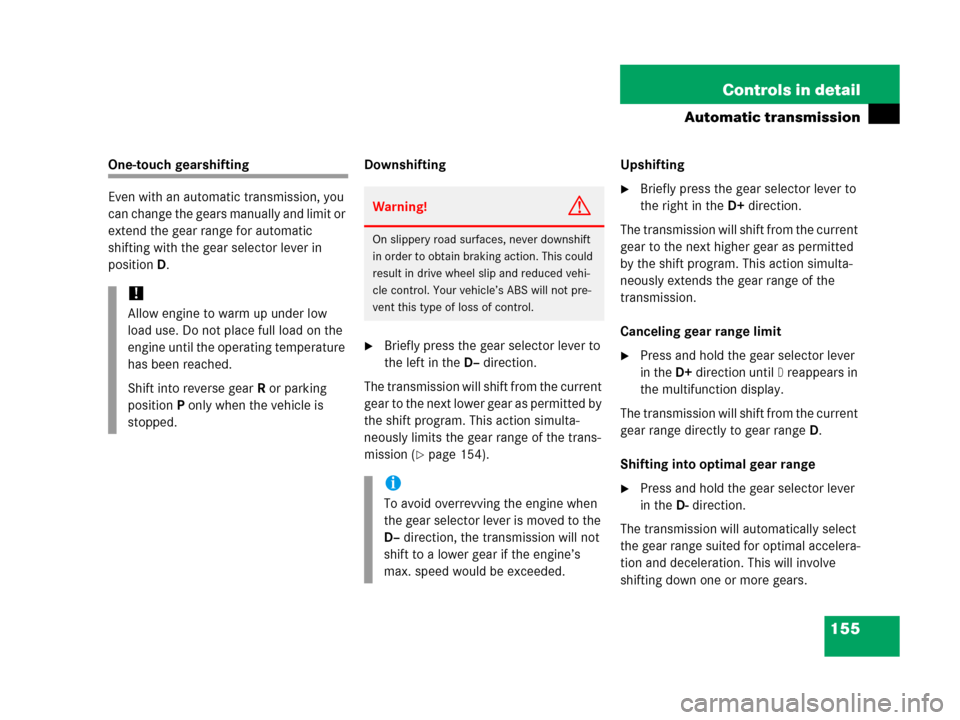
155 Controls in detail
Automatic transmission
One-touch gearshifting
Even with an automatic transmission, you
can change the gears manually and limit or
extend the gear range for automatic
shifting with the gear selector lever in
positionD.Downshifting
�Briefly press the gear selector lever to
the left in the D–direction.
The transmission will shift from the current
gear to the next lower gear as permitted by
the shift program. This action simulta-
neously limits the gear range of the trans-
mission (
�page 154).Upshifting
�Briefly press the gear selector lever to
the right in the D+direction.
The transmission will shift from the current
gear to the next higher gear as permitted
by the shift program. This action simulta-
neously extends the gear range of the
transmission.
Canceling gear range limit
�Press and hold the gear selector lever
in the D+direction until
Dreappears in
the multifunction display.
The transmission will shift from the current
gear range directly to gear rangeD.
Shifting into optimal gear range
�Press and hold the gear selector lever
in the D-direction.
The transmission will automatically select
the gear range suited for optimal accelera-
tion and deceleration. This will involve
shifting down one or more gears.
!
Allow engine to warm up under low
load use. Do not place full load on the
engine until the operating temperature
has been reached.
Shift into reverse gearR or parking
positionP only when the vehicle is
stopped.
Warning!G
On slippery road surfaces, never downshift
in order to obtain braking action. This could
result in drive wheel slip and reduced vehi-
cle control. Your vehicle’s ABS will not pre-
vent this type of loss of control.
i
To avoid overrevving the engine when
the gear selector lever is moved to the
D–direction, the transmission will not
shift to a lower gear if the engine’s
max. speed would be exceeded.
Page 157 of 417
156 Controls in detail
Automatic transmission
Emergency operation (Limp Home
Mode)
If vehicle acceleration worsens or the
transmission no longer shifts, the trans-
mission is most likely operating in limp
home (emergency operation) mode. In this
mode, only 2nd gear and reverse gear can
be activated.
�Stop the vehicle.
�Move gear selector lever toP.
�Turn off the engine.
�Wait at least ten seconds before re-
starting.
�Restart the engine.
�Move gear selector lever to positionD
(for second gear) orR.
�Have the transmission checked at an
authorized Mercedes-Benz Light Truck
Center as soon as possible.
Page 158 of 417
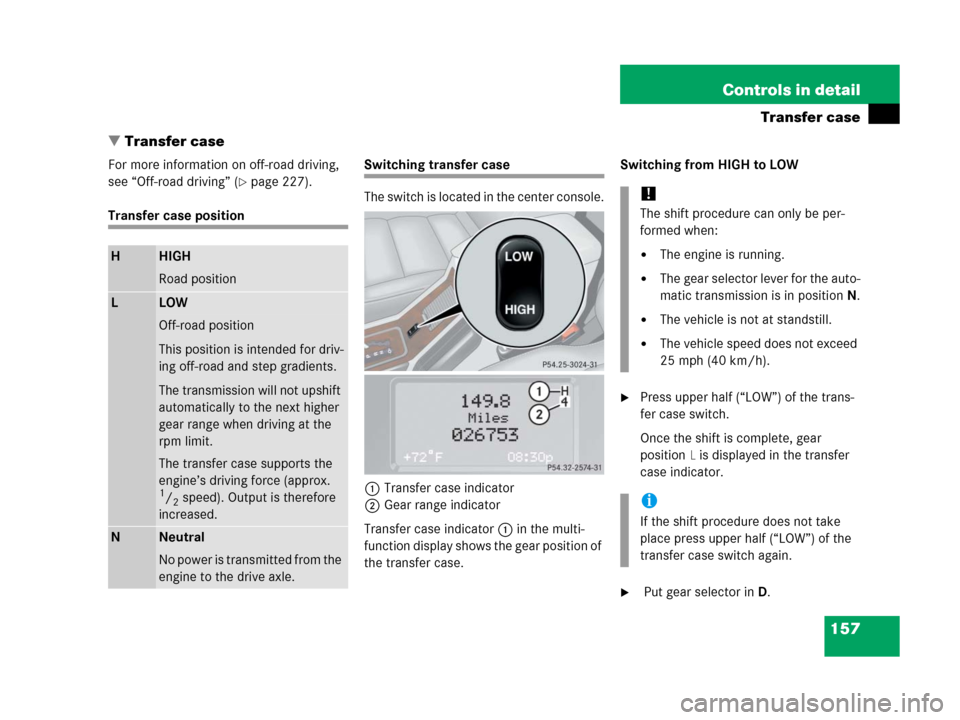
157 Controls in detail
Transfer case
�Transfer case
For more information on off-road driving,
see “Off-road driving” (
�page 227).
Transfer case position
Switching transfer case
The switch is located in the center console.
1Transfer case indicator
2Gear range indicator
Transfer case indicator1 in the multi-
function display shows the gear position of
the transfer case.Switching from HIGH to LOW
�Press upper half (“LOW”) of the trans-
fer case switch.
Once the shift is complete, gear
position
L is displayed in the transfer
case indicator.
� Put gear selector in D.
HHIGH
Road position
LLOW
Off-road position
This position is intended for driv-
ing off-road and step gradients.
The transmission will not upshift
automatically to the next higher
gear range when driving at the
rpm limit.
The transfer case supports the
engine’s driving force (approx.
1/2speed). Output is therefore
increased.
NNeutral
No power is transmitted from the
engine to the drive axle.
!
The shift procedure can only be per-
formed when:
�The engine is running.
�The gear selector lever for the auto-
matic transmission is in positionN.
�The vehicle is not at standstill.
�The vehicle speed does not exceed
25 mph (40 km/h).
i
If the shift procedure does not take
place press upper half (“LOW”) of the
transfer case switch again.
Page 223 of 417
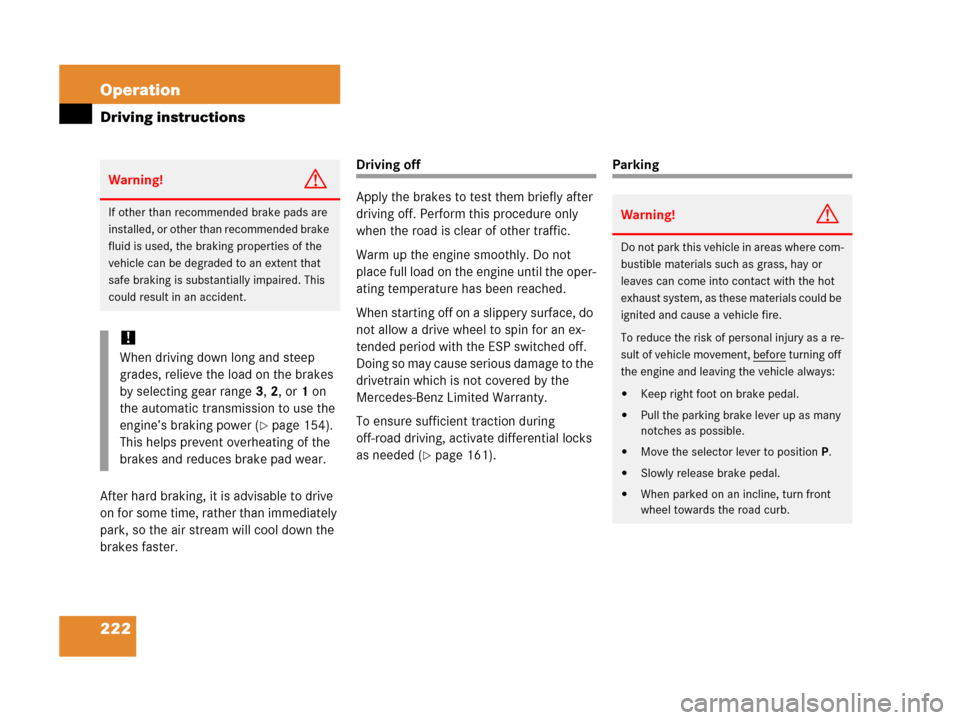
222 Operation
Driving instructions
After hard braking, it is advisable to drive
on for some time, rather than immediately
park, so the air stream will cool down the
brakes faster.
Driving off
Apply the brakes to test them briefly after
driving off. Perform this procedure only
when the road is clear of other traffic.
Warm up the engine smoothly. Do not
place full load on the engine until the oper-
ating temperature has been reached.
When starting off on a slippery surface, do
not allow a drive wheel to spin for an ex-
tended period with the ESP switched off.
Doing so may cause serious damage to the
drivetrain which is not covered by the
Mercedes-Benz Limited Warranty.
To ensure sufficient traction during
off-road driving, activate differential locks
as needed (
�page 161).
Parking
Warning!G
If other than recommended brake pads are
installed, or other than recommended brake
fluid is used, the braking properties of the
vehicle can be degraded to an extent that
safe braking is substantially impaired. This
could result in an accident.
!
When driving down long and steep
grades, relieve the load on the brakes
by selecting gear range3,2, or1 on
the automatic transmission to use the
engine’s braking power (
�page 154).
This helps prevent overheating of the
brakes and reduces brake pad wear.
Warning!G
Do not park this vehicle in areas where com-
bustible materials such as grass, hay or
leaves can come into contact with the hot
exhaust system, as these materials could be
ignited and cause a vehicle fire.
To reduce the risk of personal injury as a re-
sult of vehicle movement, before
turning off
the engine and leaving the vehicle always:
�Keep right foot on brake pedal.
�Pull the parking brake lever up as many
notches as possible.
�Move the selector lever to positionP.
�Slowly release brake pedal.
�When parked on an incline, turn front
wheel towards the road curb.
Page 232 of 417
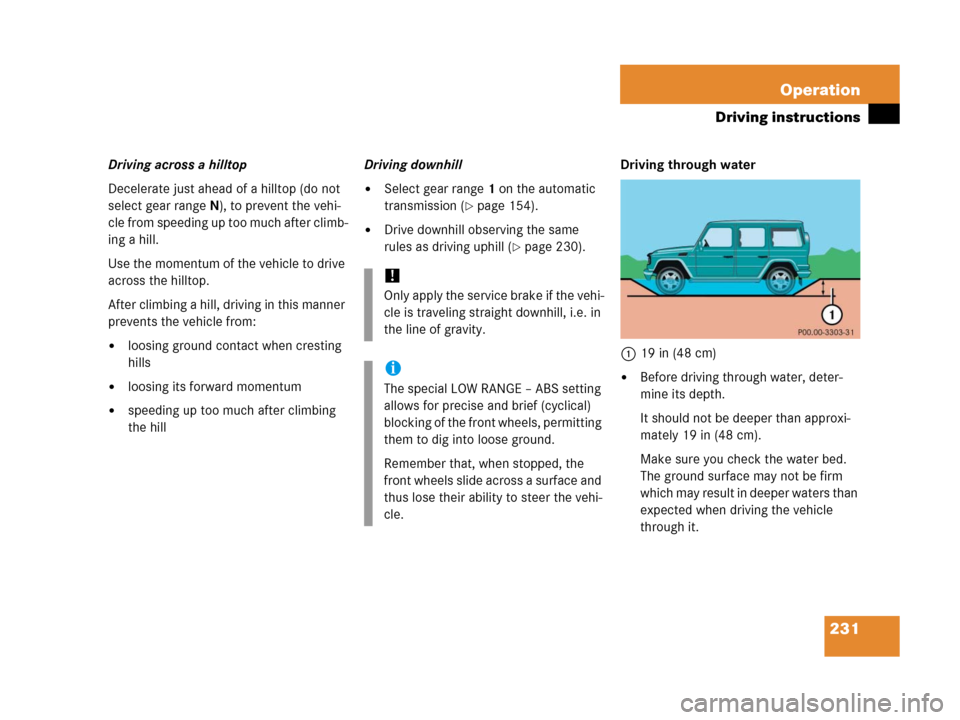
231 Operation
Driving instructions
Driving across a hilltop
Decelerate just ahead of a hilltop (do not
select gear rangeN), to prevent the vehi-
cle from speeding up too much after climb-
ing a hill.
Use the momentum of the vehicle to drive
across the hilltop.
After climbing a hill, driving in this manner
prevents the vehicle from:
�loosing ground contact when cresting
hills
�loosing its forward momentum
�speeding up too much after climbing
the hillDriving downhill
�Select gear range1 on the automatic
transmission (
�page 154).
�Drive downhill observing the same
rules as driving uphill (
�page 230).Driving through water
119 in (48 cm)
�Before driving through water, deter-
mine its depth.
It should not be deeper than approxi-
mately 19 in (48 cm).
Make sure you check the water bed.
The ground surface may not be firm
which may result in deeper waters than
expected when driving the vehicle
through it.
!
Only apply the service brake if the vehi-
cle is traveling straight downhill, i.e. in
the line of gravity.
i
The special LOW RANGE – ABS setting
allows for precise and brief (cyclical)
blocking of the front wheels, permitting
them to dig into loose ground.
Remember that, when stopped, the
front wheels slide across a surface and
thus lose their ability to steer the vehi-
cle.